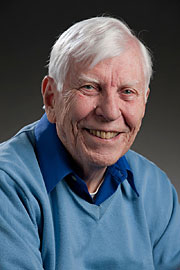- Number 341 |
- July 11, 2011
Meet Mr. Magnet

Alvin Tollestrup.
Alvin Tollestrup came to the DOE’s Fermi National Accelerator Laboratory in 1975 for what was supposed to be a six-month sabbatical. He has now been a Fermilab physicist for more than 35 years and is still making strides for the field of high-energy physics.
Tollestrup led the pioneering work of designing and testing 1,000 superconducting magnets used in the Tevatron, the four-mile-long particle accelerator at Fermilab. It was the first large-scale application of superconducting wire, which—when cooled to very low temperature—can conduct electrical currents without resistance. The use of superconducting wire allowed for the construction of stronger Tevatron magnets while reducing the energy consumption of each magnet.
Tollestrup now works on the development of stronger superconducting magnets for application in the proposed muon collider. The goal of the research is to develop high-temperature superconducting materials to make magnets several times stronger than what is currently possible. Together with David Larbalestier, from the National High Magnetic Field Laboratory at Florida State University, Tollestrup serves as co-principal investigators for a multi-institutional collaboration that received funding from the American Recovery and Reinvestment Act.
This year, the IEEE Council on Superconductivity selected Tollestrup for its award for Significant and Sustained Contributions to Applied Superconductivity. One of three recipients, Tollestrup was chosen for his many contributions to high-energy physics and to particle accelerators.
“The Tevatron was the premier accelerator in the world and many discoveries have come out of it, so it was a very major accomplishment that Alvin should be recognized for,” said Martin Nisenoff, chair of the awards committee for the IEEE Council on Superconductivity.
The award came as a total surprise to Tollestrup. One of the most rewarding components of his work has been to see the far-reaching applications of superconducting magnets in other fields of science, including chemistry, biology and medicine, Tollestrup said. He is looking forward to receiving the award on Sept. 12 at the 22nd Magnet Technology Conference in Marseille, France. — Christine Herman
Submitted by DOE's Fermi National Accelerator Laboratory
